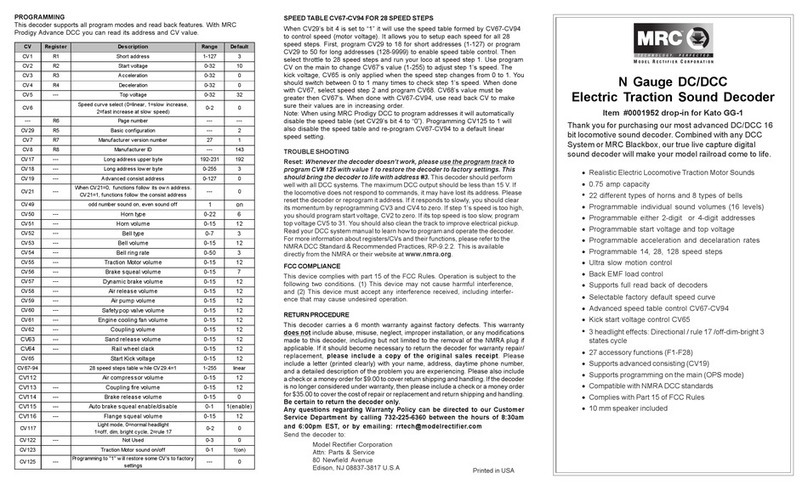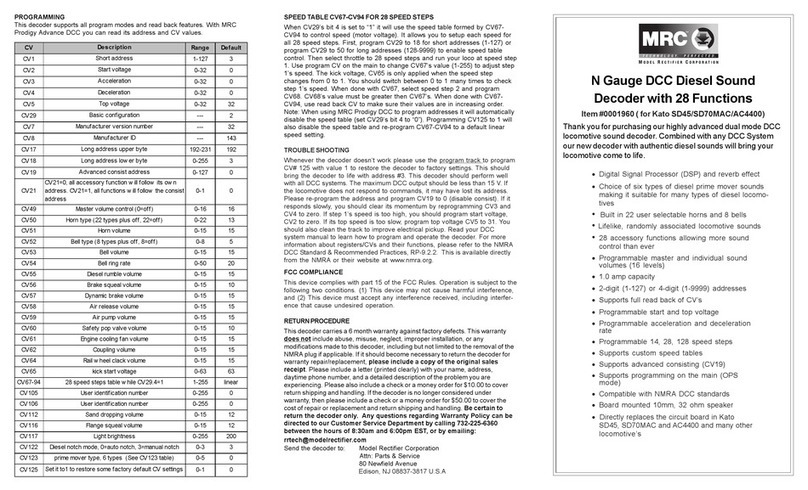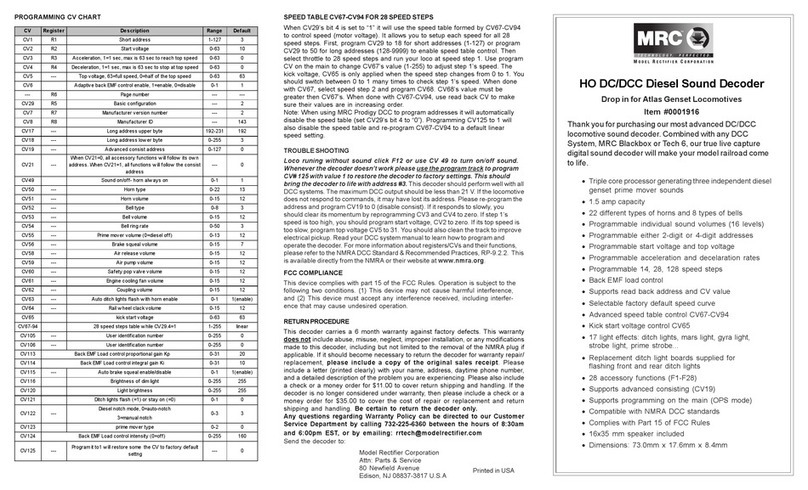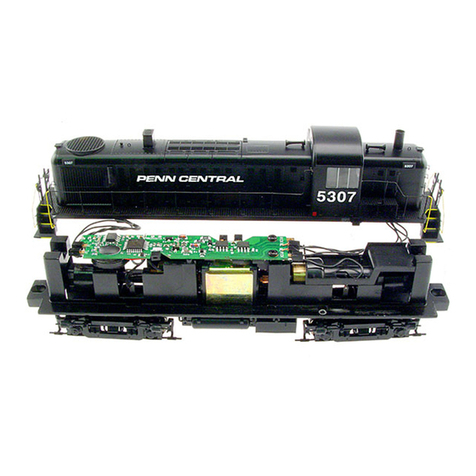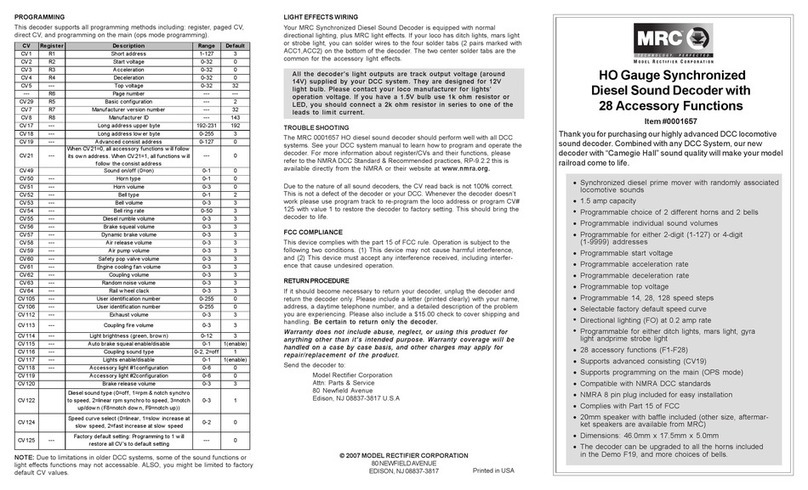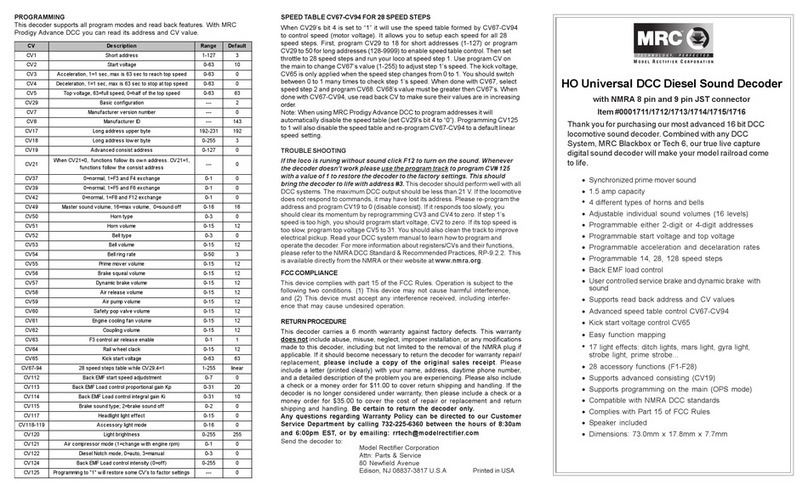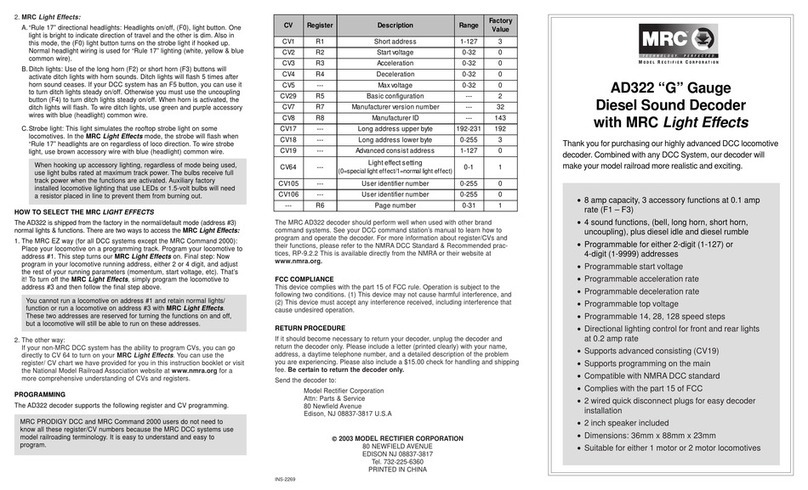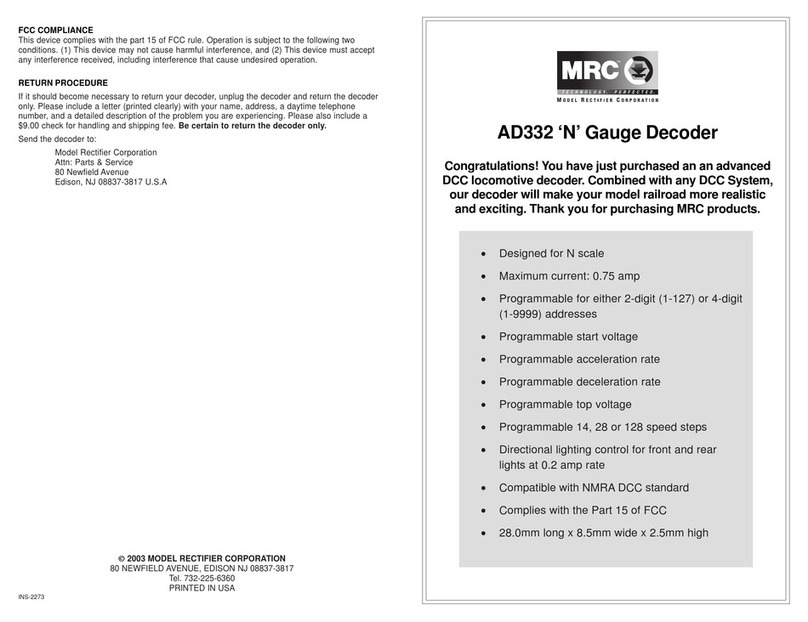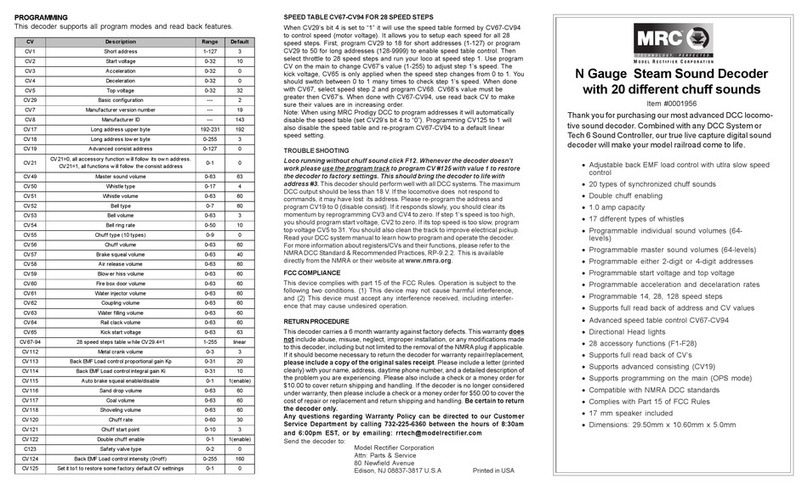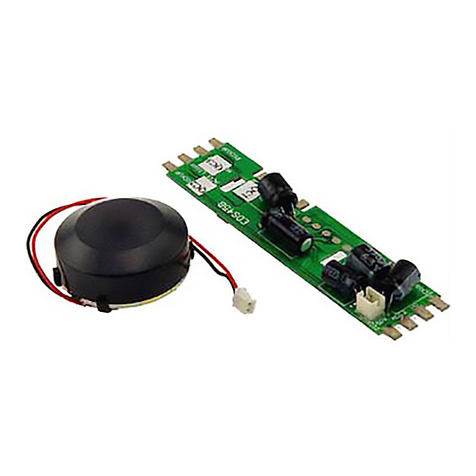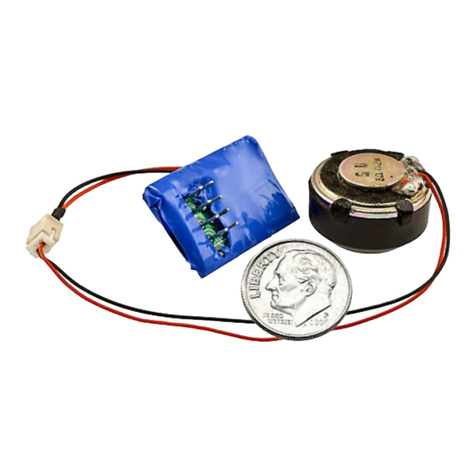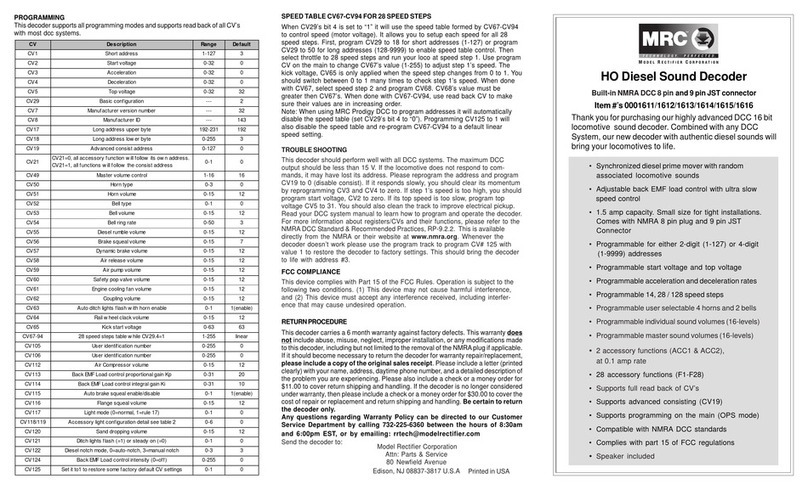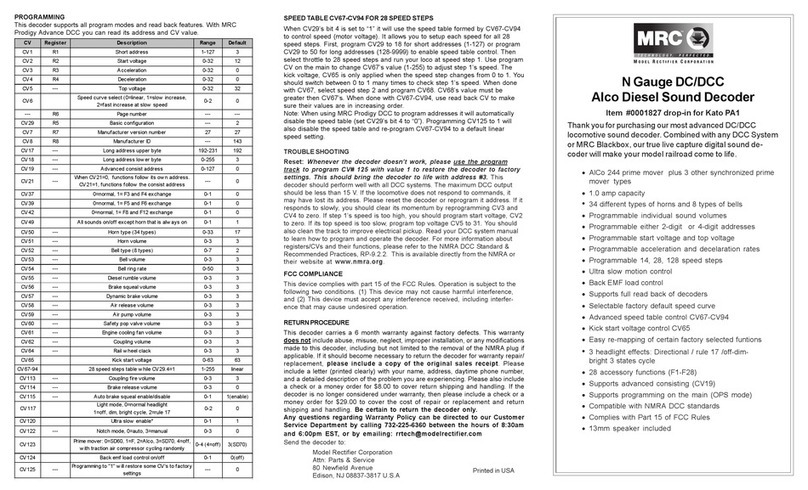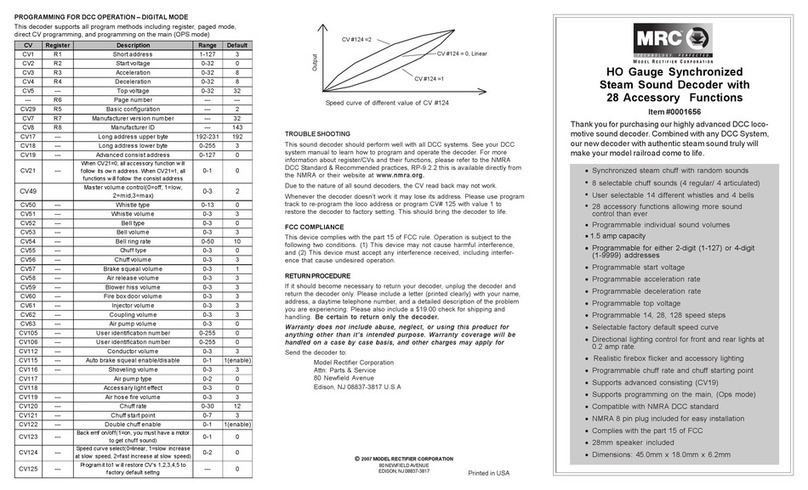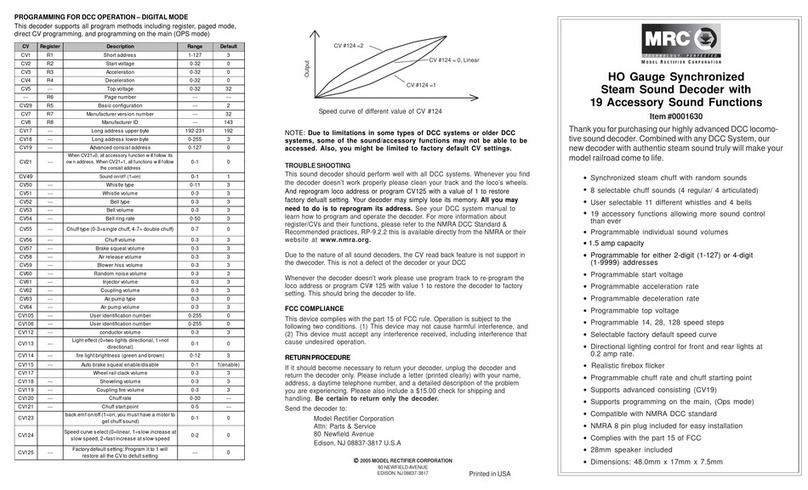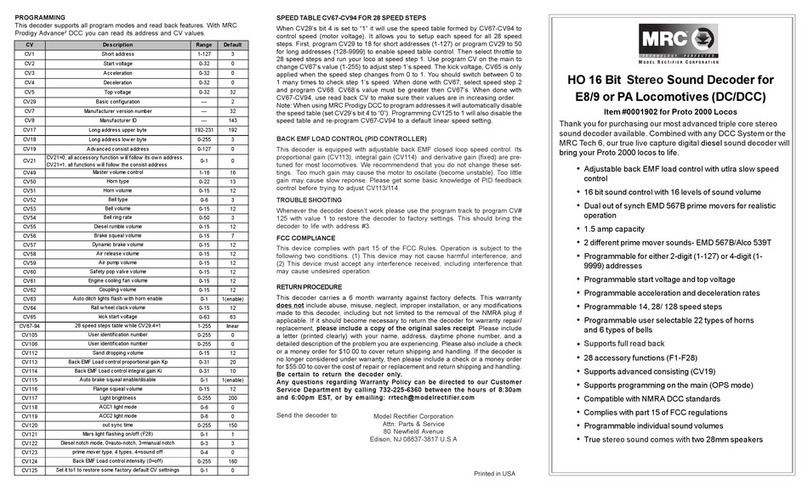
N Gauge Synchronized
Diesel Sound Decoder with
19 Accessory Sound Functions
Item #0001636
Thank you for purchasing our highly advanced DCC locomotive
sound decoder. Combined with any DCC System, our new
decoder with authentic diesel sound truly will make your model
railroad come to life.
•Synchronized diesel prime mover with randomly
associated locomotive sounds
•User selectable 15 different horns and 8 bells
•19 accessory functions allowing more sound control
than ever
•Programmable individual sound volumes
•0.75 amp capacity
•Programmable for either 2-digit (1-127) or 4-digit
(1-9999) addresses
•Programmable start voltage
•Programmable acceleration rate
•Programmable deceleration rate
•Programmable top voltage
•Programmable 14, 28, 128 speed steps
•Selectable factory default speed curve
•Directional lighting (FO) at 0.2 amp rate
•Supports advanced consisting (CV19)
•Supports programming on the main (OPS mode)
•Compatible with NMRA DCC standards
•Complies with Part 15 of FCC
•13x18mm speaker included
•PCB size: 70 x 9.2 x 5.8mm
• Directly replaces most Atlas N scale loco’s PC boards
Note: Bell, Dynamic Brake and Rail Wheel Clack cannot play at the same time. If you
active the Bell sound [F1], while either the Dynamic Brake or Rail Wheel Clack
sounds are activated, the Bell sound will override the other 2 sounds. Rail Wheel
Clack cannot play while the loco is in idle. When you turn off Dynamic brake and
Rail Wheel Clack sound there will be one second delay.
TROUBLE SHOOTING
The MRC 0001636 N diesel sound decoder should perform well with all DCC
systems. See your DCC system manual to learn how to program and operate the
decoder. For more information about register/CVs and their functions, please
refer to the NMRA DCC Standard & Recommended practices, RP-9.2.2 this is
available directly from the NMRA or their website at www.nmra.org.
Due to the nature of all sound decoders, the CV read back is not 100% correct. So
this feature is not supported in the decoder. This is not a defect of the decoder or
your DCC system.
Whenever the decoder doesn’t work please use program track to re-program the
loco address or program CV# 125 with value 1 to restore the decoder to factory
setting. This should bring the decoder to life.
FCC COMPLIANCE
This device complies with the part 15 of FCC rule. Operation is subject to the
following two conditions. (1) This device may not cause harmful interference,
and (2) This device must accept any interference received, including interfer-
ence that cause undesired operation.
RETURN PROCEDURE
If it should become necessary to return your decoder, unplug the decoder and
return the decoder only. Please include a letter (printed clearly) with your name,
address, a daytime telephone number, and a detailed description of the problem
you are experiencing. Please also include a $15.00 check for shipping and
handling. Be certain to return only the decoder.
Send the decoder to:
Model Rectifier Corporation
Attn: Parts & Service
80 Newfield Avenue
Edison, NJ 08837-3817 U.S.A
PROGRAMMING
This decoder supports all programming methods including: register, paged CV,
direct CV, and programming on the main (ops mode programming).
2005 MODEL RECTIFIER CORPORATION
80 NEWFIELDAVENUE
EDISON, NJ 08837-3817
NOTE: Due to limitations in older DCC systems, some of the sound functions or
light effects functions may not accessable. ALSO, you might be limited to
factory default CV values. Printed in USA
CV Register Description Range Default
CV1 R1 Short address 1-127 3
CV2 R2 Start voltage 0-32 0
CV3 R3 Acceleration 0-32 0
CV4 R4 Deceleration 0-32 0
CV5 --- Top voltage 0-32 32
--- R6 Page number --- ---
CV29 R5 Basic configuration --- 2
CV7 R7 Manufacturer version num ber --- 32
CV8 R8 Manufacturer ID --- 143
CV17 --- Long address upper byte 192-231 192
CV18 --- Long address lower byte 0-255 3
CV19 --- Advanced consist address 0-127 0
CV49 Sound on/off(1=on) 0-11
CV50 --- Horn type 0-15 4
CV51 --- Horn volume 0-3 3
CV52 --- Bell type 0-9 3
CV53 --- Bell volume 0-3 3
CV54 --- Bell ring rate 0-50 3
CV55 --- Dies el rum ble volum e 0-3 3
CV56 --- Brake squeal volum e 0-3 3
CV57 --- Dynamic brake volume 0-3 3
CV58 --- Air release volum e 0-3 3
CV59 --- Air pump volume 0-3 3
CV60 --- Safetypop valve volum e 0-3 3
CV61 --- Engine cooling fan volume 0-3 3
CV62 --- Coupling volum e 0-3 3
CV63 --- Random noise volume 0-3 3
CV64 --- Rail wheel clack 0-3 3
CV105 --- User identification num ber 0-255 0
CV106 --- User identification num ber 0-255 0
CV115 --- Auto brake squeal enable/disable 0-1 1(enable)
CV116 --- Coupling sound type 0-2, 2=off 1
CV117 --- Lights enable/disable 0-1 1(enable)
CV119 Coupling fire volum e 0-3 3
CV120 Brake release volume 0-3 3
CV121 random noise enable 0-1 1(enable)
CV122
Diesel sound type (0=off, 1=rpm &
notch synchro to speed, 2=linear rpm
synchro to speed, 3=notch up/down
(F8=notch down, F9=notch up))
0-3 1
CV124
Speed curve select (0=linear, 1=slow
increase at slow speed, 2=fast
increase at slow speed
0-2 0
CV125 --- Factory default setting: Programming to 1
will restoreall CV'stodefault setting
---0
CV21---0
When CV21=0,allaccessory functions will
follow its ow n address. When CV21=1, all
functionswill followtheconsistaddress
---













